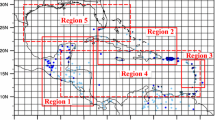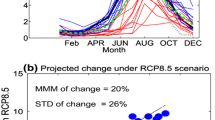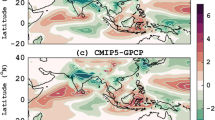Abstract
We assess the ability of Global Climate Models participating in phases 3 and 5 of the Coupled Model Intercomparison Project (CMIP3 and CMIP5) to simulate observed annual precipitation cycles over the Caribbean. Compared to weather station records and gridded observations, we find that both CMIP3 and CMIP5 models can be grouped into three categories: (1) models that correctly simulate a bimodal distribution with two rainfall maxima in May–June and September–October, punctuated by a mid-summer drought (MSD) in July–August; (2) models that reproduce the MSD and the second precipitation maxima only; and (3) models that simulate only one precipitation maxima, beginning in early summer. These categories appear related to model simulation of the North Atlantic Subtropical High (NASH) and sea surface temperature (SST) in the Caribbean Sea and Gulf of Mexico. Specifically, models in category 2 tend to anticipate the westward expansion of the NASH into the Caribbean in early summer. Early onset of NASH results in strong moisture divergence and MSD-like conditions at the time of the May–June observed precipitation maxima. Models in category 3 tend to have cooler SST across the region, particularly over the central Caribbean and the Gulf of Mexico, as well as a weaker Caribbean low-level jet accompanying a weaker NASH. In these models, observed June-like patterns of moisture convergence in the central Caribbean and the Central America and divergence in the east Caribbean and the Gulf of Mexico persist through September. This analysis suggests systematic biases in model structure may be responsible for biases in observed precipitation variability over the Caribbean and more confidence may be placed in the precipitation simulated by the GCMs that are able to correctly simulate seasonal cycles of SST and NASH.









Similar content being viewed by others
References
Adler RF, Huffman GJ, Chang A, Ferraro R, Xie P, Janowiak J, Rudolf B, Schnerider U, Curtis S, Bolvin D, Gruber A, Susskind J, Arkin P (2003) The version 2 global precipitation climatology project (GPCP) monthly precipitation analysis (1979-present). J Hydrometeorol 4:1147–1167
Amador J (1998) A climatic feature of the tropical Americas: the trade wind easterly jet. Top Meteor Oceanogr 5:1–13
Barnes SL (1964) A technique for maximizing details in numerical weather map analysis. J Appl Meteorol 3:396–409
Cook KH, Vizy EK (2010) Hydrodynamics of the Caribbean low-level jet and its relationship to precipitation. J Clim 23:1477–1494
Covey C, AchutaRao KM, Cubasch U, Jones P, Lambert S, Mann M, Phillips T and Taylor K (2003) An overview of results from the Coupled Model Intercomparison Project (CMIP). Glob Planet Chang 103–133
Curtis S, Gamble DW (2007) Regional variations of the Caribbean mid-summer drought. Theor Appl Climatol. doi:10.1007/s00704-007-0342-0
Cressman GP (1959) An operational objective analysis system. Mon Weather Rev 87:367–374
Davis RE, Hayden BP, Gay DA, Phillips WL, Jones GV (1997) The North Atlantic subtropical anticyclone. J Clim 10:728–744
Diem JE (2013) Comments on “Changes to the North Atlantic subtropical high and its role in the intensification of summer rainfall variability in the southeastern United States”. J Clim 26:679–682
Enfield DB, Alfaro EJ (1999) The dependence of Caribbean rainfall on the interaction of the tropical Atlantic and Pacific Oceans. J. Clim 12:2093–2103
Gamble DW, Curtis S (2008) Caribbean precipitation: review, model, and prospect. Prog Phys Geogr 32(3):265–276
Gamble DW, Parnell DB, Curtis S (2008) Spatial variability of the Caribbean mid-summer drought and relation to north Atlantic high circulation. Int J Climatol 28:343–350
Giannini A, Kushnir Y, Cane MA (2000) Interannual variability of Caribbean Rainfall, ENSO, and the Atlantic Ocean. J Clim 13:297–311
Hawkins E, Sutton R (2011) The potential to narrow uncertainty in projections of regional precipitation change. Clim Dyn 37:407–418
Houghton RW (1991) The relationship of sea surface temperature to thermocline depth at annual and interannual time scales in the tropical Atlantic Ocean. J Geophys Res 96:15,173–15185
Inoue M, Handoh IC, Bigg GR (2002) Bimodal distribution of tropical cyclogenesis in the Caribbean: characteristics and environmental factors. J Clim 15:2897–2905
Jury MR (2009a) A quasi-decadal cycle in Caribbean climate. J Geophys Res 114:D13102. doi:10.1029/2009JD011741
Jury MR (2009b) An intercomparison of observational, reanalysis, satellite, and coupled model data on mean rainfall in the Caribbean. J. Hydrometeol 10:413–430
Jury MR, Malmgren BA, Winter A (2007) Subregional precipitation climate of the Caribbean and relationships with ENSO and NAO. J Geophys Res 112:D16107. doi:10.1029/2006JD007541
Kelly P and Mapes B (2011) Zonal mean wind, the Indian monsoon, and July drying in the western Atlantic subtropics. J Geophys Res 116:D00Q07. doi:10.1029/2010JD015405
Li W, Li L, Fu R, Deng Y, Wang H (2011) Changes to the North subtropical high and its role in the intensification of summer rainfall variability in the southeastern United States. J Clim 24:1499–1506
Li L, Li W, Kushnir Y (2012) Variation of the North Atlantic subtropical high western ridge and its implication to Southeastern US summer precipitation. Clim Dyn 39:1401–1412
Li L, Li W, Deng Y (2013a) Summer rainfall variability over the Southeastern United States and its intensification in the 21st century as assessed by CMIP5 models. J Geophys Res 118:1–15. doi:10.1002/jgrd.50136
Li W, Li L, Fu R, Deng Y, Wang H (2013b) Reply to “comments on changes to the north Atlantic subtropical high and its role in the intensification of summer rainfall variability in the southeastern United States”. J Clim 26:683–688
Lienert F, Fyfe JC, Merryfield WJ (2011) Do climate models capture the tropical influence on north Pacific sea Surface Temperature variability? J Clim 24:6203–6209
Magaña V, Amador JA, Medina S (1999) The midsummer drought over Mexico and Central America. J Clim 12:1577–1588
Malmgren BA, Winter A, Chen D (1998) El Niño southern oscillation and North Atlantic oscillation control of climate in Puerto Rico. J Clim 11:2713–2717
Martin ER, Schumacher C (2011) The Caribbean low-level jet and its relationship with precipitation in IPCC AR4 models. J Clim 24:5935–5950
Meehl GA, Covey C, McAvaney B, Latif M, Stouffer RJ (2005) Overview of the coupled model intercomparison project. Bull Am Meteorol Soc 86:89–93
Moss RH et al (2010) The next generation of scenarios for climate change research and assessment. Nature 463:747–756
Munoz E, Busalacchi AJ, Nigam S, Ruiz-Barradas A (2008) Winter and summer structure of the Caribbean low-level jet. J Clim 21:1260–1276
Nakicenovic N, Swart R (eds) (2000) IPCC special report on emissions scenario. Cambridge University Press, UK
Rahmstorf S, Cazenave A, Church J, Hansen J, Keeling R, Parker D, Somerville R (2007) Recent climate observations compared to projections. Science 316(5825):709. doi:10.1126/science.1136843
Rauscher SA, Giorgi F, Differnbaugh NS, Seth A (2008) Extension and intensification of the Meso-American mid-summer drought in the twenty-first century. Clim Dyn. doi:10.1007/s00382-007-0357-1
Reynolds RW, Rayner NA, Smith TM, Stokes DC, Wang W (2002) An improved in situ and satellite SST analysis for climate. J Clim 15:1609–1625
Small RJO, de Szoeke SP, Xie SP (2007) The central American midsummer drought: regional aspects and large-scale forcing. J Clim 20:4853–4873
Stensrud DJ (1996) Importance of low-level jets to climate: a review. J Clim 9:1698–1711
Stoner A, Hayhoe K, Wuebbles D (2009) Assessing general circulation model simulations of atmospheric teleconnection patterns. J Clim 22:4348–4372
Taylor KE, Stouffer RJ, Meehl GA (2012) An overview of CMIP5 and the experiment design. Bull Am Meteorol Soc 93:485–498
Uppala SM et al (2005) The ERA-40 re-analysis. Q J R Meteorol Soc 131:2961–3012
Wang C (2007) Variability of the Caribbean low-level jet and its relations to climate. Clim Dyn 29:411–422
Wang C, Enfield DB (2003) A further study of the tropical Western Hemisphere warm pool. J Clim 16:1476–1493
Wang C, Lee SK (2007) Atlantic warm pool, Caribbean low-level jet and their potential impact on atlantic hurricanes. Geophys Res Lett 34:L02703. doi:10.1029/2006GL028579
Whyte F, Taylor M, Stephenson T, Campbell J (2008) Features of the Caribbean low level jet. Int J Climatol 28:119–128
Yu L, Jin X, Weller RA (2006) Role of net surface heat flux in seasonal variations of sea surface temperature in the tropical Atlantic Ocean. J Clim 19:6153–6169
Acknowledgments
The authors would like to thank two anonymous reviewers for constructive suggestions that improved this manuscript. We also thank Mr. Caleb Crow for quality control of station data. We acknowledge the World Climate Research Programme’s Working Group on Coupled Modelling, which is responsible for CMIP, and we thank the climate modeling groups (listed in Table 1 of this paper) for producing and making available their model output. For CMIP the U.S. Department of Energy’s Program for Climate Model Diagnosis and Intercomparison provides coordinating support and led development of software infrastructure in partnership with the Global Organization for Earth System Science Portals. This research was supported by USGS Award Number G10AC00582.
Author information
Authors and Affiliations
Corresponding author
Rights and permissions
About this article
Cite this article
Ryu, JH., Hayhoe, K. Understanding the sources of Caribbean precipitation biases in CMIP3 and CMIP5 simulations. Clim Dyn 42, 3233–3252 (2014). https://doi.org/10.1007/s00382-013-1801-1
Received:
Accepted:
Published:
Issue Date:
DOI: https://doi.org/10.1007/s00382-013-1801-1




